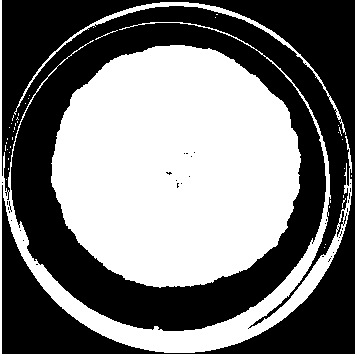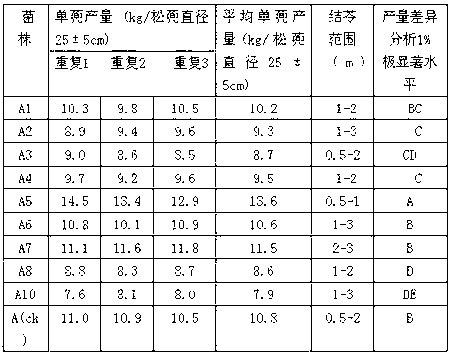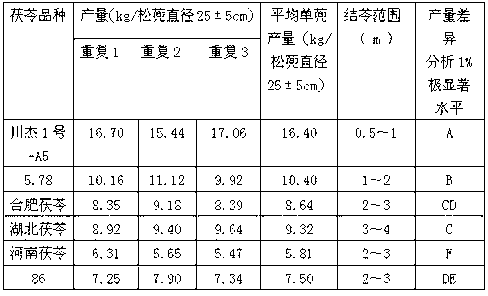Low-carbon and high-yield poria culture method
A Poria cocos, high-yield technology, applied in the field of low-carbon high-yield Poria cocos cultivation, can solve the problems of insignificant strain yield and low genetic stability of the strain, and achieve the effects of solving the contradiction between strains, reducing strength and improving work efficiency
- Summary
- Abstract
- Description
- Claims
- Application Information
AI Technical Summary
Problems solved by technology
Method used
Image
Examples
Embodiment 1
[0019] 1 strain selection
[0020] Poria cocos breeding research using protoplast ultraviolet mutagenesis technology with "Minling" as parent: preparation of "Minling" mycelial protoplasts, and diluting the protoplasts to 1.25×10 6 1 / ml, 0.1 ml each was spread on the CYM regeneration medium, and irradiated with a 15w ultraviolet lamp for mutagenesis. The petri dish was 30 cm away from the lamp tube, and after turning on the lamp to preheat for 20 min, open the dish cover to irradiate for 150 s. After the ultraviolet mutagenesis was completed, the plates were tightly wrapped with black paper, and cultured at 28°C for 5-7 days. After the protoplasts were regenerated, 120 robust and pure colonies (numbered W1-W120) that grew out first were selected, and transferred into PDA medium for culture. Taking the growth rate of mycelium on the PDA plate as the primary screening standard, 30 regenerated strains (numbered P1-P30) with the highest growth rate were screened out. Taking the...
Embodiment 2
[0058] A method for cultivating Poria cocos with low carbon and high yield, the specific operations are as follows:
[0059] 1. Selecting the venue
[0060] Lingchang should be far away from pollution sources. The air quality should meet the GB3095-96 air environment quality level two, the soil quality should reach the GB15618-95 soil environment quality standard level two, and the water source should meet the GB5084-92 farmland irrigation water quality standard. Lingchang should choose to sit north or south. Sitting west and facing east, the altitude is 300-1500M, the slope is 10-50 degrees, full sun, ventilation and no water accumulation, the soil is loose sandbag soil, which is slightly acidic (pH5.5-6).
[0061] Selection: Choose healthy pine bushes with a tree diameter of more than 20 cm that have been felled for 1-2 years.
[0062] 2. Strain production
[0063] 2.1 Strain requirements
[0064] Select the high-quality, high-yielding, strong stress-resistant Poria varie...
Embodiment 3
[0097] Example 3 Comparative test of "Chuanjie No. 1" and "Chuanjie No. 1-A5"
[0098] In the early 1990s, our institute bred the "Chuanjie No. 1" variety through the induction and domestication of wild Poria cocos strains. The early test results of this variety showed that it was also a more suitable variety for the cultivation of Poria cocos pine. However, after several years of cultivation and application It shows that its genetic stability is slightly poor, and the strain has degenerated phenomenon. So in 2000, we used the wild Poria cocos strain "Minling" as the parent, and applied protoplast ultraviolet mutagenesis technology to breed a new Poria cocos variety "Chuanjie No. 1-A5". The yield of Jieling is particularly outstanding, and the average yield per pine can reach 15kg / diameter of more than 25±5cm. In 2010, a comparison test of two varieties of Lingling was carried out in the forest farm of Shuibei Town, Shaowu County. The statistical analysis of the test results ...
PUM
 Login to View More
Login to View More Abstract
Description
Claims
Application Information
 Login to View More
Login to View More - R&D
- Intellectual Property
- Life Sciences
- Materials
- Tech Scout
- Unparalleled Data Quality
- Higher Quality Content
- 60% Fewer Hallucinations
Browse by: Latest US Patents, China's latest patents, Technical Efficacy Thesaurus, Application Domain, Technology Topic, Popular Technical Reports.
© 2025 PatSnap. All rights reserved.Legal|Privacy policy|Modern Slavery Act Transparency Statement|Sitemap|About US| Contact US: help@patsnap.com



